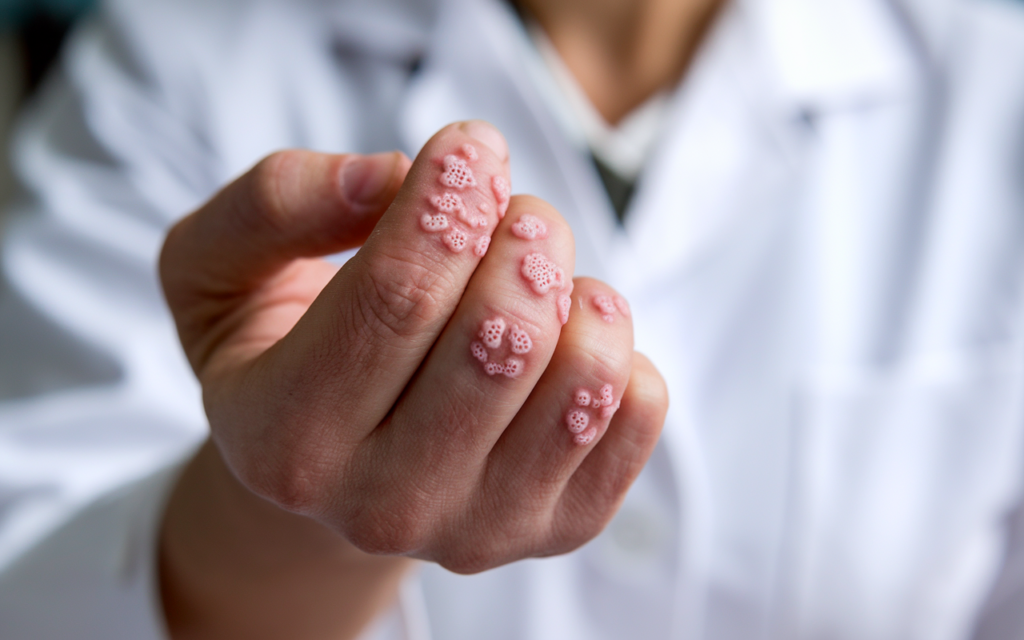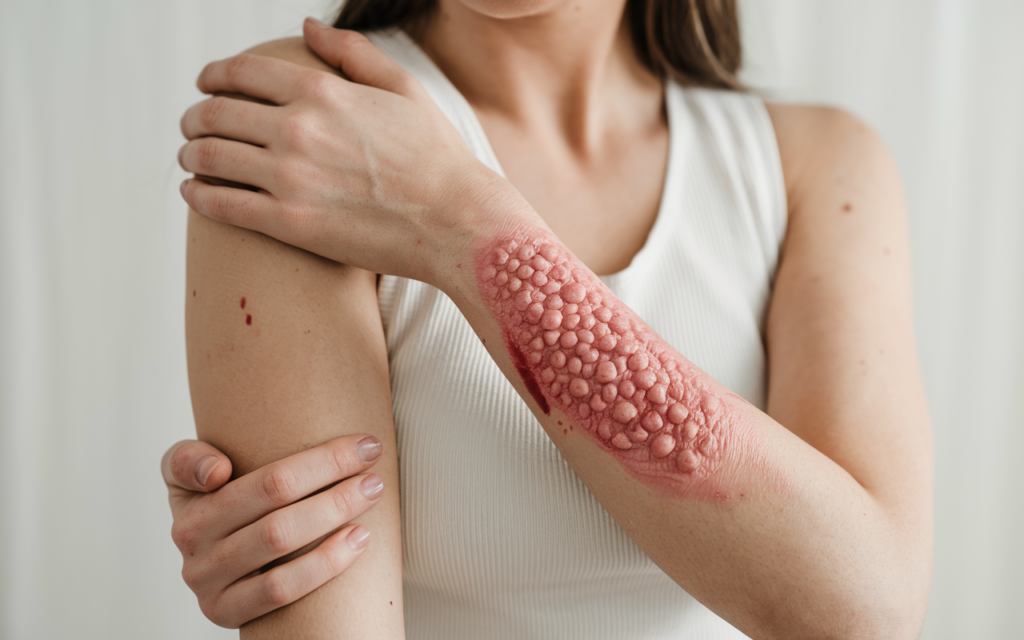Introduction
Healthcare topics often intersect in fascinating ways, bridging diverse medical domains to offer deeper insights. Two such areas of interest are vesicular rashes and normal HbA1c levels. At first glance, these are unrelated. However, closer inspection reveals overlapping connections, particularly in the realm of metabolic health and skin conditions. In this article, we’ll explore the details of vesicular rashes, the significance of maintaining normal HbA1c levels, and their potential interrelation.
Vesicular Rash: Understanding the Condition
A vesicular rash is characterized by the appearance of small, fluid-filled blisters, often grouped on the skin. These lesions, or cysts, are usually surrounded by redness and may be associated with symptoms such as itching, burning, or pain. Vesicular rashes can occur for a variety of reasons, with causes ranging from infections to autoimmune responses.
Common Causes of Vesicular Rash
The most frequent cause of vesicular rashes is viral infections, particularly those caused by the herpes simplex virus (HSV) and varicella-zoster virus (VZV). HSV is responsible for cold sores and genital herpes, while VZV causes chickenpox and shingles. Both conditions manifest as painful or itchy clusters of blisters, often accompanied by systemic symptoms like fever or fatigue.

Other causes include contact dermatitis, which occurs when the skin reacts to an allergen or irritant, and autoimmune disorders such as dermatitis herpetiformis. This condition, linked to gluten sensitivity, results in itchy vesicles, primarily on the elbows, knees, and buttocks.
In some cases, bacterial infections, such as impetigo, can mimic vesicular rashes. It highlights the importance of proper diagnosis to ensure accurate treatment.
Diagnosis and Management of Vesicular Rash
Diagnosing a vesicular rash involves a combination of clinical evaluation and laboratory testing. Doctors often start with a detailed medical history and physical examination to narrow down potential causes. Laboratory tests, such as viral cultures, polymerase chain reaction (PCR) testing, or skin biopsies, can confirm the diagnosis.
Treatment varies depending on the underlying cause; for viral rashes like those caused by HSV or VZV, antiviral medications such as acyclovir or valacyclovir are commonly prescribed. In the case of contact dermatitis, avoiding the triggering allergen or irritant and using topical steroids can provide relief. Autoimmune-related rashes may require more intensive therapy, including oral steroids or immunosuppressive drugs.
HbA1c: A Key Marker of Metabolic Health
HbA1c, also known as glycated hemoglobin, is an essential marker in assessing long-term blood sugar control. Unlike daily glucose tests, which provide a snapshot of blood sugar levels, HbA1c reflects average glucose levels over the past two to three months. A normal HbA1c level is generally considered to be below 5.7%.
Why Normal HbA1c Levels Matter
Normal HbA1c levels are a strong indicator of effective glucose regulation, reducing the risk of developing diabetes or its complications. For individuals already diagnosed with diabetes, maintaining a normal or near-normal HbA1c level is critical for minimizing long-term complications such as neuropathy, retinopathy, and cardiovascular disease.
The test is particularly useful for detecting prediabetes, a state in which blood sugar levels are elevated but not high enough to qualify as diabetes. Lifestyle interventions at this stage can often reverse the progression to diabetes, making HbA1c testing a powerful preventive tool.

The Connection Between Vesicular Rash and HbA1c
While vesicular rashes and HbA1c levels may seem unrelated, they can intersect in specific scenarios, particularly in the context of diabetes and its complications. Individuals with diabetes often experience a variety of skin conditions, some of which may present as vesicular rashes.
Diabetes and Skin Manifestations
Diabetes is associated with several skin disorders due to its effects on the immune system, circulation, and nerve function. Poorly controlled blood sugar levels can impair the skin’s ability to heal and fight infections, increasing the risk of bacterial and fungal skin conditions.
Bullous diabeticorum, for example, is a rare but notable condition that occurs in diabetic patients. It presents as spontaneous blisters, which can resemble vesicular rashes, often on the hands, feet, or lower legs. While the exact cause is unclear, it is believed to be linked to long-term damage from elevated blood sugar levels.
Additionally, fungal infections such as candidiasis and bacterial infections like impetigo may produce vesicle-like lesions in individuals with diabetes. These conditions underscore the importance of maintaining normal HbA1c levels to prevent complications.
Managing Vesicular Rashes in Diabetic and Non-Diabetic Patients
Management of vesicular rashes in the context of normal HbA1c levels requires addressing both the skin condition and any underlying metabolic or systemic factors. For diabetic patients, achieving and maintaining normal HbA1c levels is a cornerstone of treatment. It can help reduce the risk of skin infections and other complications.
Strategies for Maintaining Normal HbA1c Levels
Achieving normal HbA1c levels involves a combination of lifestyle modifications and medical interventions. Regular physical activity, a balanced diet low in refined sugars and high in fiber, and adherence to prescribed medications are all critical components. Monitoring blood sugar levels at home and scheduling regular HbA1c tests can provide valuable feedback on progress.
For individuals without diabetes, maintaining normal HbA1c levels is equally important for overall health. It can reduce the risk of developing diabetes and its associated complications, including skin conditions.

Vesicular Rash and Normal HbA1c: A Holistic Perspective
The relationship between vesicular rashes and normal HbA1c levels highlights the interconnected nature of health. Skin conditions can serve as early indicators of systemic issues, prompting further investigation into underlying metabolic or immune dysfunctions. Conversely, poor glucose control, as indicated by elevated HbA1c levels, can predispose individuals to skin conditions, including vesicular rashes.
Prevention and Long-Term Outlook
Preventing vesicular rashes and maintaining normal HbA1c levels requires a proactive
approach. For individuals prone to skin conditions, identifying and avoiding triggers can minimize recurrence. It may involve using hypoallergenic skin care products, avoiding known allergens, and seeking prompt treatment for infections.
For those managing diabetes, maintaining normal HbA1c levels is a powerful tool in preventing a wide range of complications. It includes not only skin conditions but also cardiovascular, renal, and neurological complications.
Conclusion: Bridging Dermatology and Metabolic Health
Vesicular rashes and normal HbA1c levels, though seemingly unrelated, reveal significant interconnections when examined closely. Skin conditions like vesicular rashes can sometimes signal deeper systemic issues, including poor glucose control. Similarly, maintaining normal HbA1c levels is essential for preventing complications that may manifest on the skin.
By adopting a comprehensive and proactive approach to health, individuals can address the root causes of these conditions, improving outcomes and overall well-being. The intersection of dermatology and metabolic health continues to be a rich area for research and clinical advancements, promising better care for patients in the future.



